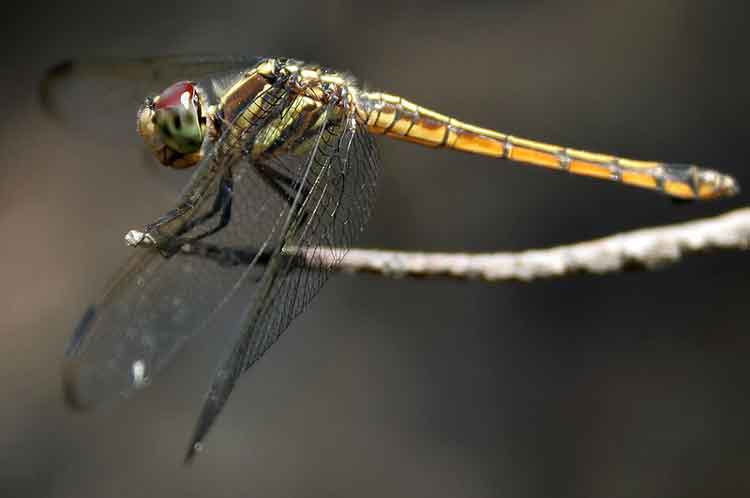
Potamarcha congener (*)
Superregnum: Eukaryota
Cladus: Unikonta
Cladus: Opisthokonta
Cladus: Holozoa
Regnum: Animalia
Subregnum: Eumetazoa
Cladus: Bilateria
Cladus: Nephrozoa
Cladus: Protostomia
Cladus: Ecdysozoa
Cladus: Panarthropoda
Phylum: Arthropoda
Subphylum: Hexapoda
Classis: Insecta
Cladus: Dicondylia
Subclassis: Pterygota
Cladus: Metapterygota
Cladus: Odonatoptera
Cladus: Holodonata
Ordo: Odonata
Subordo: Epiprocta
Infraordo: Anisoptera
Superfamilia: Libelluloidea
Familia: Libellulidae
Subfamilia: Libellulinae
Genus: Potamarcha
Species: Potamarcha congener
Name
Potamarcha congener (Rambur, 1842)
References
http://www.iucnredlist.org/apps/redlist/details/167281
Potamarcha congener[3] is a species of dragonfly in the family Libellulidae.[4] It was first described by Jules Pierre Rambur in 1842,[1] almost fifty years before Friedrich Karsch described its genus.[5] Potamarcha congener is one of two species making up the genus Potamarcha, together with Potamarcha puella.[5]
Distribution
Potamarcha congener is common through much of its range, which stretches through parts of South Asia, South-East Asia, and Oceania, including in countries such as India, Indonesia, China, Australia, and Vietnam. Owing to its wide distribution, the species has been classified as Least Concern by the International Union for Conservation of Nature.[1][6]
Description and habitat
Potamarcha congener, known as a yellow-tailed ashy skimmer, common chaser, or swampwatcher,[7] is a medium-sized dragonfly with a bluish black thorax and yellow tail with black markings. Face is olivaceous yellow to steel black or brown. Eyes are reddish brown above and bluish grey below. In male adults, the thorax and first four segments of the abdomen are covered with bluish pruinescence. In young adults, yellow markings are visible through the pruinescence. The rest of the abdomen is black with orange markings, with the last two segments entirely black. The female thorax has yellow and black stripes on the sides. The abdomen is black with dull orange markings, and has prominent flaps on each side of segment eight. The flaps may serve to hold the eggs in place during oviposition.[8][9][10][11]
This dragonfly is found in terrestrial areas with standing water. This can include near small ponds, rice fields or marshes where it breeds.[8][1]
References
Mitra, A.; Dow, R.A. (2017). "Potamarcha congener". IUCN Red List of Threatened Species. 2017: e.T167281A87528800. doi:10.2305/IUCN.UK.2017-1.RLTS.T167281A87528800.en. Retrieved 20 November 2021.
Rambur, Jules (1842). Histoire naturelle des insectes. Névroptères (in French). Paris: Librairie Encyclopédique de Roret. pp. 534 [70] – via Gallica.
Dennis Paulson; Martin Schorr; Cyrille Deliry. "World Odonata List". University of Puget Sound. Retrieved 15 Feb 2022.
"Species Potamarcha congener (Rambur, 1842)". Australian Faunal Directory. Australian Biological Resources Study. 2012. Retrieved 1 March 2017.
"Species in the genus Potamarcha". John Carroll University. Retrieved 3 April 2014.
K.A., Subramanian; K.G., Emiliyamma; R., Babu; C., Radhakrishnan; S.S., Talmale (2018). Atlas of Odonata (Insecta) of the Western Ghats, India. Zoological Survey of India. pp. 368–369. ISBN 9788181714954.
Theischinger, Günther; Hawking, John (2006). The Complete Field Guide to Dragonflies of Australia. Collingwood, Victoria, Australia: CSIRO Publishing. p. 268. ISBN 978 0 64309 073 6.
C FC Lt. Fraser (1936). The Fauna of British India, including Ceylon and Burma, Odonata Vol. III. Red Lion Court, Fleet Street, London: Taylor and Francis. pp. 289–291.
C FC Lt. Fraser (1924). A Survey of the Odonate (Dragonfly) Fauna of Western India and Descriptions of Thirty New Species (PDF). p. 432.
"Potamarcha congener Rambur, 1842". India Biodiversity Portal. Retrieved 2017-02-16.
"Potamarcha congener Rambur, 1842". Odonata of India, v. 1.00. Indian Foundation for Butterflies. Retrieved 2017-02-16.
Retrieved from "http://en.wikipedia.org/"
All text is available under the terms of the GNU Free Documentation License

